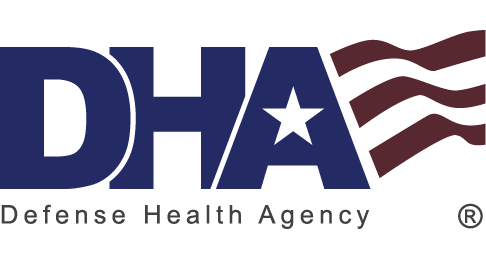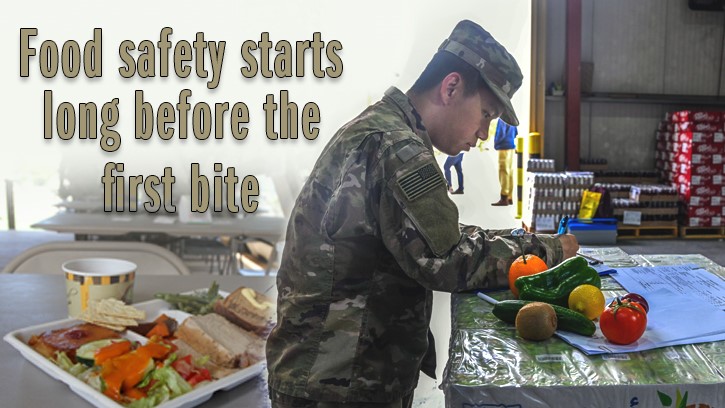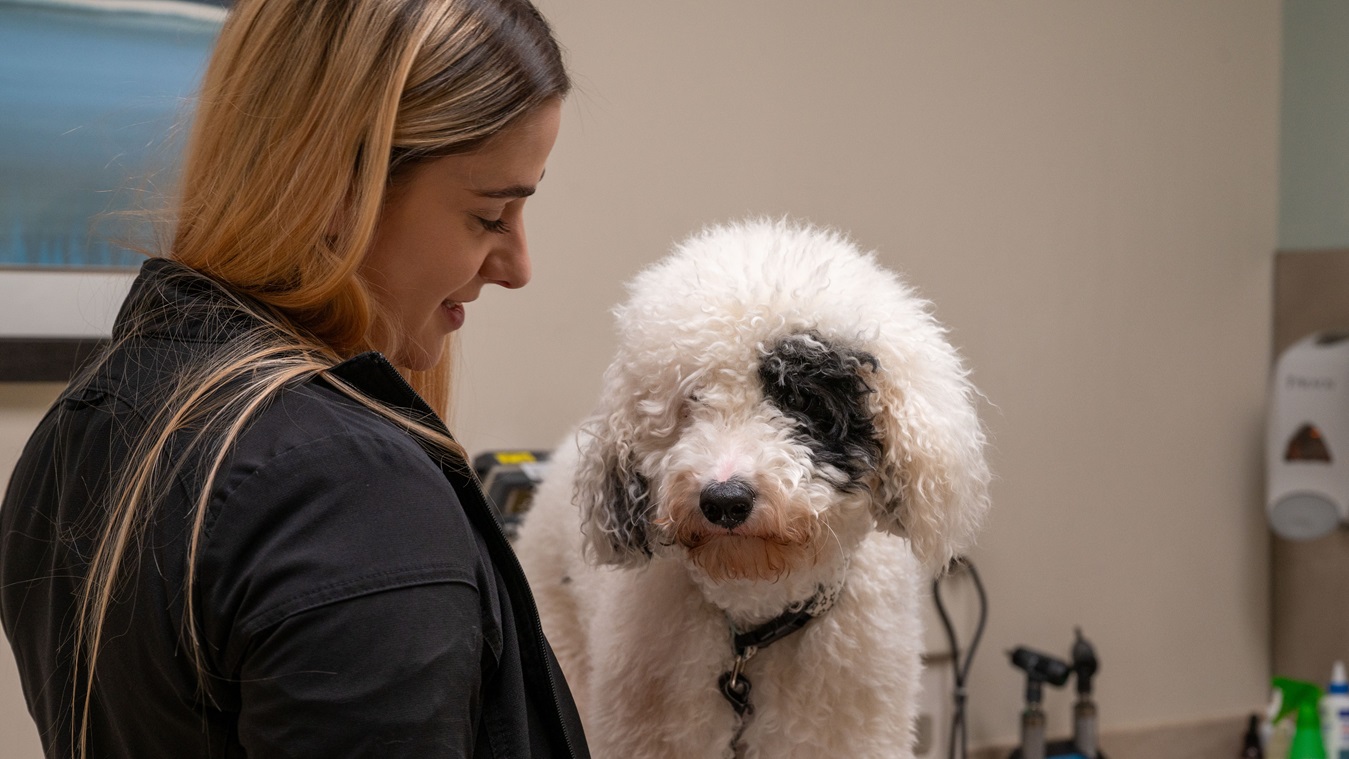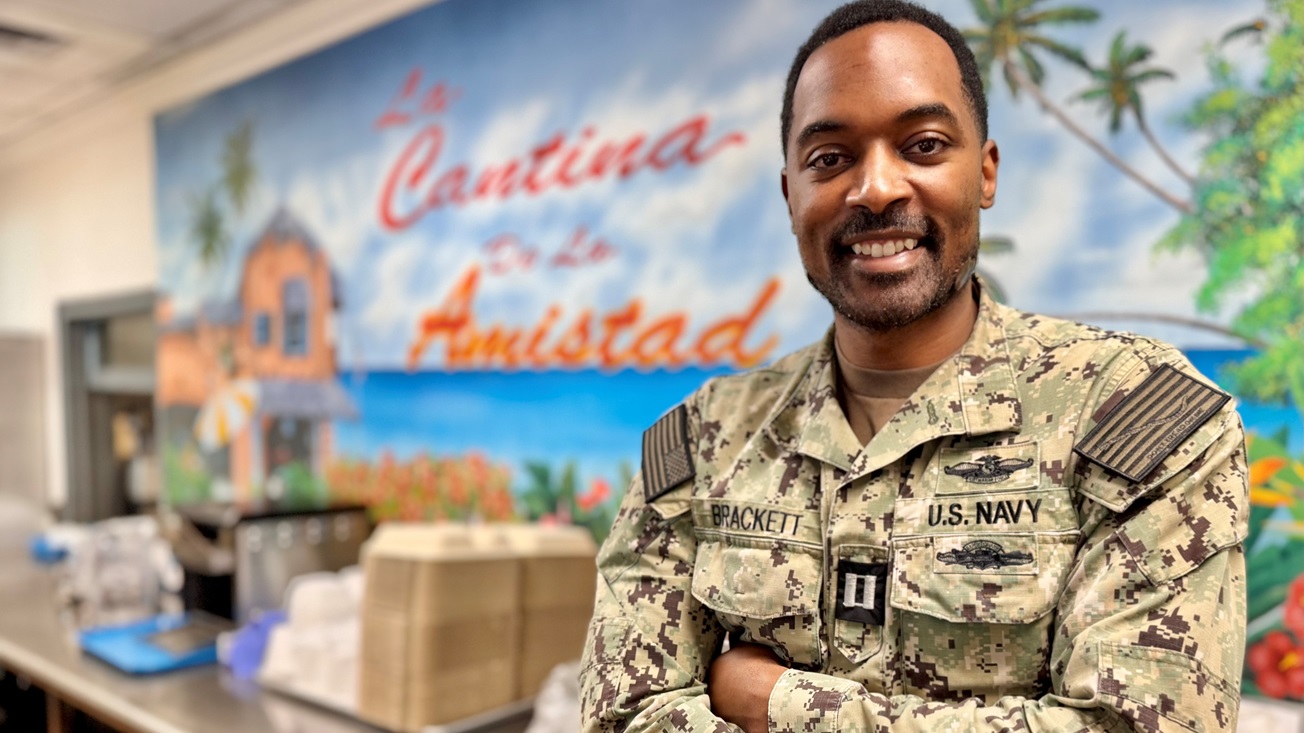July 09, 2025 | By Douglas Holl, Defense Health Agency-Public Health Public Affairs
When service members are deployed, their safety depends on much more than their personal protective equipment and extensive training. Safety starts with what’s on their plate.
Behind every meal served to a soldier, sailor, airman, Guardian, or Marine, the U.S. Army Veterinary Corps is working hard to make sure that food is safe to eat, whether in the field or at the installation dining facility.
The mission of the veterinary corps goes beyond taking care of animals. Its expertise plays a vital role in ensuring food safety and public health protection across the Department of Defense.
Food Safety Starts Long Before the First Bite
Specialized Medical Detachment (Veterinary Service Support) teams, or MDVSSs, evaluate food safety in the field and at military bases, said U.S. Army Chief Warrant Officer 5 Oscar Carrión, Interagency Integrator (Food Protection) at Defense Health Agency Veterinary Services Division in Falls Church, Virginia. These detachments work under defined guidelines based on troop numbers and operational scope, providing scalable support whether the mission involves 60,000 troops in combat or 12,000 in humanitarian-support roles.
The veterinary corps accomplishes these actions not only with active duty assets, but the U.S. Army Reserve constantly supports the global combatant commands as well, said Carrión. “Our USAR MDVSSs fill constant rotations to U.S. Central Command and support U.S. Southern Command,” he said. “Without the USAR VC component, the active duty VC assets would be stretched thin.”
These teams support high-profile training exercises, overseas deployments, disaster relief operations, and U.S. Navy resupply missions, said Carrión. Their role is crucial in maintaining food safety whether at sea, on the ground, or in the air. “We are key participants in pre-deployment activities and high-visibility exercises around the world,” said Carrión.
The MDVSSs not only evaluate the quality of food upon arrival, but they also inspect and test items for signs of spoilage, contamination, and storage issues, said Carrión. Their inspections include visual checks and rapid-diagnostic tests to catch threats early. These checks ensure all food received is safe and originates from DOD-approved sources. “We’re focused on food safety for all service members,” said Carrión. “MDVSS teams conduct sanitation audits of food vendors and facilities to ensure compliance with military food safety standards. Field units often rely on local suppliers, so these audits are essential to avoid introducing unfamiliar or unregulated risks into the supply chain.”
Battling Invisible Enemies
U.S. Army Lt. Col. Melissa Hehr, deputy chief, DHA Veterinary Services Division, says the U.S. Army Veterinary Corps treats bacteria and viruses like an enemy force. “If we think of foodborne pathogens as an enemy force, with the capability to move virtually undetected throughout the operational environment, then the connection between illness prevention and warfighter lethality becomes much clearer,” she said.
The enemy in this case includes norovirus, salmonellosis, listeriosis, toxoplasmosis, campylobacteriosis and infections caused by Staphylococcus aureus and E. coli. Some of these pathogens are common at home and in base or garrison environments, while others, such as cholera or brucellosis, and intestinal parasites are more likely to be encountered overseas.
“The veterinary corps’ deterrence strategy is to deploy capabilities that will disrupt pathogen freedom of movement from the environment to a food source, whether it’s an animal intended for food, or a fresh fruit or vegetable,” said Hehr. “We do this by inspecting food sources for evidence of disease or contamination, then neutralizing any detected threats.”
The food safety management system uses hazard analysis and critical control points, or HACCP, to ensure that even if a pathogen does infiltrate food-processing operations, it is still denied access, said Hehr. By setting up layered safety mechanisms such as temperature controls, secure transport, and facility sanitation audits, the veterinary corps helps intercept these threats before they can reach a service member’s tray or mess kit.
“Pathogens that make it through are met with control points we monitor vigilantly, and if needed, we destroy them with heat or chemicals,” she said. “Essentially, the veterinary corps’ offensive posture towards foodborne illness enemies enables the warfighter to focus on being G.I. Joe, without the threat of GI flow!”
Food safety Critical to Warfighter Lethality
A foodborne illness can shut down a unit faster than an ambush. It doesn’t matter how advanced U.S. warfighting technology is—or even how robust U.S. military healthcare capabilities are—food safety is an essential requirement for combat effectiveness, said Hehr.
The dangers of contaminated food range from minor gastrointestinal distress to full-blown outbreaks that can leave dozens of personnel unable to perform their duties. “Without life-sustaining food, warfighters are 100% combat-ineffective,” she said. “Protecting the food supply is paramount to maintaining force health and combat readiness. That’s why the veterinary corps works tirelessly around the globe to lead DOD’s food protection mission, diligently defending the food supply from threats, expertly ensuring food safety, and resolutely enabling lethality.”
Creating a Culture of Clean and Safe Meals
Food safety isn’t a one-person job. It requires training, teamwork, and leadership support. “A culture of food safety is a team effort,” said Carrión. “It depends greatly on the unit’s leadership and combatant commanders to support it just as much as any other safety measure critical to the DOD mission.”
The veterinary corps partners with culinary specialists, preventive medicine teams, and unit field sanitation crews to build that culture, said Carrión. From handwashing stations to kitchen audits, every piece matters. Field sanitation teams are particularly important for teaching troops how to maintain personal hygiene in austere environments. “We eat at least three meals every day,” said Carrión. “So, the safety of our food, the cooking process, and sanitation at our dining facilities are critical, especially during deployments.”
Creating a strong food safety culture also involves education. The Joint Culinary Center of Excellence and U.S. Army Medical Center of Excellence provide training for food service personnel and public health specialists. This training reinforces the idea that preventing illness is just as important as preparing tasty meals.
The Quiet Professionals
Service members may not see the behind-the-scenes work the veterinary corps does every day, and that’s okay with Carrión. Their goal is to prevent problems before they start. Even small actions such as checking the temperature of food, ensuring clean water sources, or inspecting local vendors can have a major impact on the health of deployed forces. When illnesses do occur, these teams are ready to assist preventive medicine assets in investigating outbreaks, tracing sources, and implementing corrective actions immediately. “Our silent public health and culinary service assets are always on duty protecting the force,” he said.
So, the next time you unwrap an MRE or head through the chow line, remember that your meal is not just food—it’s fuel—and the Army Veterinary Corps’ professionals are there to ensure you can consume it safely.
Additional Resources
- Joint Culinary Center of Excellence
- U.S. Army Medical Center of Excellence - Veterinary Corps
- Defense Health Agency - Veterinary Services
- Food and Drug Administration - Safe Food Handling
The Defense Health Agency supports our Nation by improving health and building readiness–making extraordinary experiences ordinary and exceptional outcomes routine.
NOTE: The mention of any non-federal entity and/or its products is for informational purposes only, and is not to be construed or interpreted, in any manner, as federal endorsement of that non-federal entity or its products.








